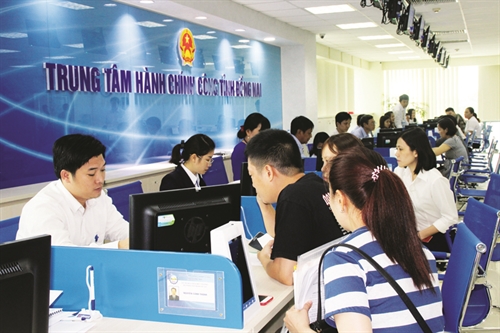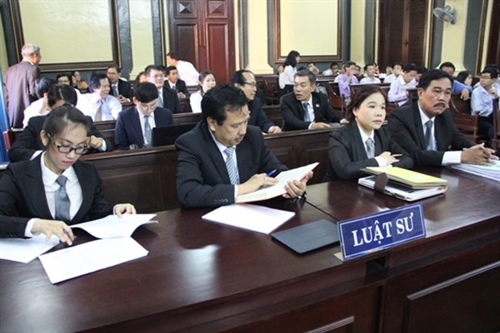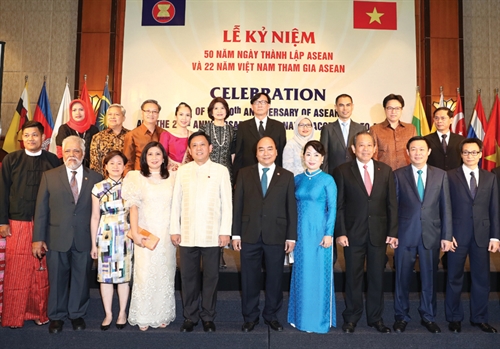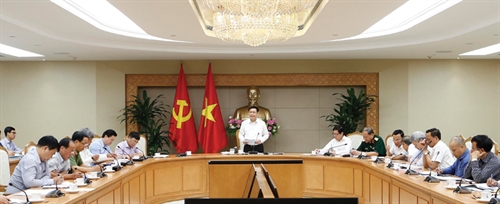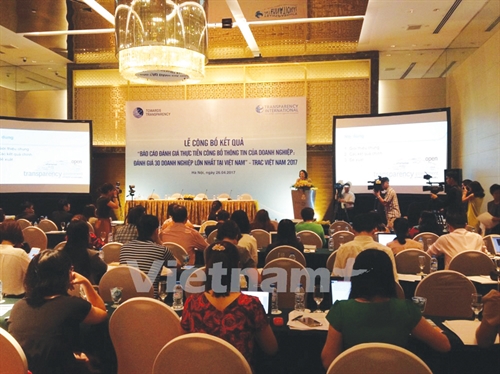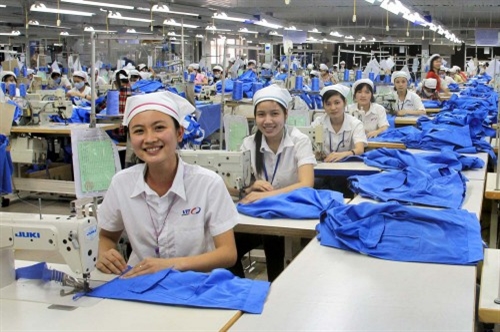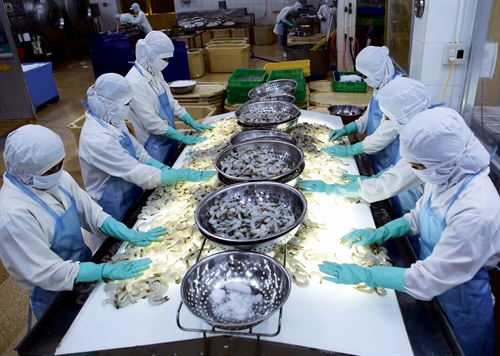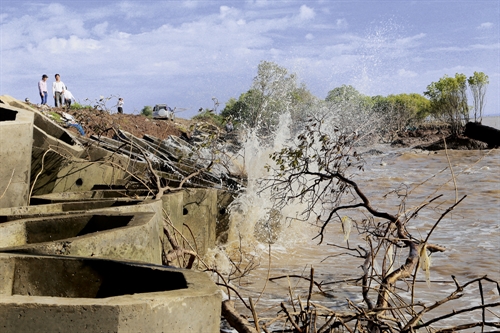Nguyen Hong Thao
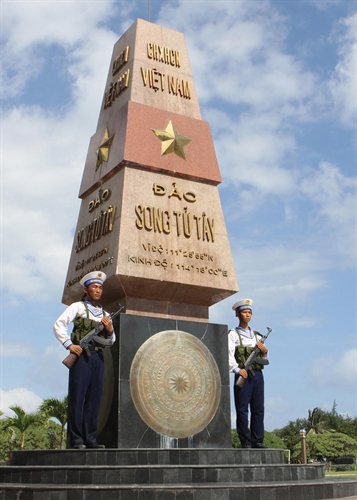 |
| Soldiers guard the marker of sovereignty on Song Tu Tay island (Spratly archipelago, Khanh Hoa province)__Photo: Duong Giang/VNA |
The tension in the South China Sea (called the East Sea in Vietnam) in 2017 is considered lower than in previous years. The Chairman’s statement of the 31st ASEAN Summit on November 13, 2017, took note of the improving relations between ASEAN and China in relation to the South China Sea matter.[1] How should this improvement be explained? What are main factors affecting that improvement? Are the South China Sea disputes being managed? To answer those questions, the main events into this region must be taken in consideration.
Political Summits
In geopolitical terms, three major events have affected the South China Sea situation: the 50th Anniversary of the ASEAN on August 8, 2017, in Manila, the 19th National Congress of the Communist Party of China on October 18-24, 2017, and the 25th APEC Economic Leaders’ Summit in Da Nang from November 6-11, 2017. As a rule, before any major event, the tension in the South China Sea would be stirred up. However, in 2017, the three events occurred consecutively in the capitals of three principal claimants within a short period of time. Their success would depend on the restraint of each party and the mutual compromise. China has decreased its land reclamation activities before President Xi Jinping declared that “Construction on islands and reefs in the South China Sea has seen steady progress” and it became one of the key accomplishments of his first term in power.[2] President Rodrigo Duterte had even ordered to stop the construction on Sandy Cay before the opening of the Chinese Party Congress. Repsol activities in the continental shelf of Vietnam are temporally halted at the moment when the seismic data had been comparably collected and before the process of adoption of the Framework for the Code of Conduct (COC).
The South China Sea Award
Another factor cannot be ignored. The year 2017 is a one-year landmark of the South China Sea Award. It has changed substantially the scope of disputes in the South China Sea. The ruling clarified the ambiguity of the nine-dash line that China had used as a legal tool to claim a major part of the South China Sea. It allocates all features in Spratlys only 12 nm territorial sea and the submerged low-tide features no legal status of rock. As a consequence, it creates the possibility to liberate almost exclusive economic zones claimed for the mainland and big islands of surrounding states, particularly Vietnam, the Philippines, Brunei, Malaysia and Indonesia, from the disputes. It creates a donut hole of the high seas and seabed area of the Common Heritage of Mankind in the center of the South China Sea, where all states, whether coastal or landlocked, can exercise the freedom of the high seas and the right to share natural resources of the seabed under the administration of the International Seabed Authority. These freedoms are universally recognized, enshrined in the United Nations Convention on the Law of the Sea (UNCLOS) and regarded as erga omnes rights. The ASEAN members, which are divided into two groups of disputing states and non-disputing states without direct interest in the South China Sea, can now realize at least a common interest in the high seas and Area - common heritage of mankind. Laos, a landlocked state, or Cambodia, a geographically disadvantaged one, is now entitled to claim its share in the South China Sea. Navigation rights and marine environment protection are underlined. The ruling clearly points out legitimate interests which third-party states are entitled to. These states may apply this ruling to protecting these interests. No doubt, the Award is shaping a new framework of cooperation and creating favorable conditions for the settlement of maritime disputes in the South China Sea.
Despite of the initial excited feelings, the Award’s conclusions have not been mentioned in any regional political statement. The two consecutive ASEAN Statements, at the 30th Summit hosted by Laos in 2016 and at the 31st Summit with the leadership of the Philippines in 2017, kept silent on the ruling. The Da Nang Declaration on the 25th APEC Economic Leaders’ Meeting on November 11, 2017, commends ASEAN contributions to regional development and prosperity.[3] The Joint Statement between the United States of America and the Socialist Republic of Vietnam on the occasion of the official visit of President Donald Trump to Hanoi on November 12, 2017, “further called for all South China Sea claimants to clarify and comport their maritime claims in accordance with the international law of the sea as reflected in the 1982 UNCLOS and to implement their international legal obligations in good faith in managing or resolving these disputes.”[4]
Some observers raised doubts about the ruling’s effect. Carl Thayer called it “dead in the water”[5]. Ankit Panda and Prashanth Parameswaran put the question: “One year after the South China Sea Arbitration Award, has China ‘won’?”[6]
Indeed, there is no any signal that the Award would be executed in the short term. The reason is lack of goodwill of case-parties. The Chinese four “no” policy (non-participation, non-recognition of the Tribunal’s jurisdiction, non-acceptance and non-enforcement of the award) puts the implementation of the ruling in the temporal deadlock. The Philippines put aside the verdict in favor of them to exchange Chinese economic investment and status quo in the South China Sea. The President of the Philippines called the Award “a piece of paper with four corners.”[7] For him, “The South China Sea is one but we are not in a hurry. And as a matter of fact, what we did was really the correct step and to avoid confrontational talks with almost all of the parties concerned, just ask for a limited time to solve the problem and share the resources if it could be done.”[8] Manila wants to focus more on economic development and stop terrorism than the dispute with the northern giant country.
China’s statement neither to accept nor to obey the Award does not mean that this state will never accept and obey it in the future. The Award is final and without appeal. It becomes undetachable part of the interpretation and application of the UNCLOS. It would be cited by jurisprudence and invoked by other parties in similar cases. In case either party refuses to accept the Award or there remains any controversy between the parties, either of them is entitled to request the Tribunal to further interpret its ruling. History proved that in almost cases of non-compliance with judgments[9], the absent party had finally modified their behaviors to adapt wholly or partly to the ruling in time.
In reality, China has some adjustments. It has even allowed Filipino fishermen to return to fish at Scarborough Shoal. It sent signals through the Philippine authority that it would not occupy new features or territory in the South China Sea[10] under a new “status quo” proposed by Manila as both sides try to strengthen their relations. It put forward a new tactic of Four Sha legal maneuver to replace the nine-dash line.[11] China calls the island groups Pratas, Paracels, Spratlysand underwater Macclesfield as Dongsha, Xisha, Nansha, and Zhongsha, respectively. The concept of the Four Sha approach with the claims of 200 nm from those features will help China control the entirety of the South China Sea. China intends to join the historic claim with the new development of the Law of the Sea to replace the nine-dash line which raises anxiety throughout the region and is nullified by the Award. Foreign Minister Wang tried to justify island building in the South China Sea: “China’s construction in the area is also aimed at maintaining regional peace and navigation safety. Most of the infrastructure projects are for civil purposes.”[12]
It’s obvious that China doesn’t concede sovereignty and jurisdiction claims on the South China Sea. Meanwhile, it has seen the need to adjust its approach after the Award. China has taken account of the support of the ASEAN countries for its “One Road, One Belt” initiative. It also needs playing time for the geopolitical struggle with America. One of the tools to achieve those objectives is the management of the COC building process.
The COC building process
The management of conflicts through the Code of Conduct of the Parties has started since the ASEAN Declaration on the South China Sea in 1992. After 10 years of talks, ASEAN-China Declaration on the Conduct of the Parties in the South China Sea (DOC) was signed. The DOC requires the Parties to exercise self-restraint in the conduct of activities that would complicate or escalate disputes and affect peace and stability in this area. However, massive land reclamation on the Spratlys and Paracels Islands at the beginning of 2013, the Hai Yang Shi You 981 oil rig incident in Vietnam’s north economic exclusive zone in 2014, and the Scarborough Shoal standoffs of 2012 and 2015 proved that the DOC is insufficient for helping concerned parties achieve their goals. ASEAN insisted on having a new COC in 2012, ten years after the DOC. China accepted the negotiations only after the Philippines brought the case to the Hague’s Permanent Court of Arbitration. Beijing wants to have something to calm discontent and suspicion in the region. It has seen the talk on COC would to stall for time, play down the significance of the arbitral ruling, prioritize satisfying domestic nationalism, attempt to secure rules that eliminate interference by outsiders, and complete the militarization of its artificial islands. ASEAN in the year of its 50th anniversary wants to have a step forward to end 15 years without essential success of the DOC. A new framework for COC is a concession from both opposite intentions. It is a political solution that both ASEAN and China want to have in 2017. The adoption of the framework for COC helps remind ASEAN of its central role in keeping peace and stability in the region through the implementation of international law, especially the UNCLOS.[13] It assists China in imposing the rule of game that COC can be achieved if “the situation in the South China Sea is generally stable and on the premise that there is no major interference from outside parties.”[14] The one A4 page of the framework for the COC listed the names of same principles contained in the 2002 DOC without concrete proposals. The hotline measures and management of incidents are added. There is no mention on the scope of application, principles, legally binding nature, enforcement mechanism, and participation of other non-regional parties. The 20th ASEAN-China Summit, held on November 13, 2017, in Manila, the Philippines, called to start the negotiation “toward the conclusion of an effective COC.” The 23rd ASEAN-China Joint Working Group Meeting on the Implementation of the DOC will be held in Vietnam in early 2018.[15] Even in the Joint Statement of Vietnam and China on November 13, 2017: “The two sides consented to fully and effectively implement the Declaration on the Conduct of Parties in the East Sea (DOC) and work toward the early formation of a Code of Conduct of Parties in the East Sea (COC) on the basis of consensus consultation, effectively managing maritime disputes and avoiding actions that would further complicate or expand the disputes for the maintenance of peace and stability in the East Sea.”[16] A legally binding nature of the COC, what is the willingness of most of ASEAN members, is replaced with the word “effective”, which has less enforcement nature. This means that the final COC is not easy to achieve at the end of the coming year 2018 as planned. It’s unlikely to stop the Beijing’s ambition to control the whole South China Sea. However, the negotiation on the COC can give a ray of hope to manage the conflict. Debate is better than use of force or militarization.
American first without American leadership in Asia
The longest and most ambitious Asia trip of President Donald Trump had been expected to consolidate the American leadership in restraining the exaggerated activities of China in the South China Sea. Meanwhile, the outcomes of the trip proved that the South China Sea is not American main concern. The speeches of President Trump underlined mostly on the North Korea nuclear threat and American bilateral trade deficits. In the Xi-Trump joint statement, there is no any word on the South China Sea.[17] President Trump’s suggestion to moderate for the South China Sea dispute even sparked anxiety among Southeast Asia leaders about the possibility of bargaining under the table between the US and China. The joint statement between the US and Singapore on October 23, 2017, only mentioned “promoting freedom of navigation in the South China Sea” without mentioning China’s move to build artificial islands and establish military outposts.[18] The new US vision of a “free and open Indo-Pacific” without action plan puts the South East Asia at the periphery of American strategy. In other words, some observers have to put the question whether the Donald Trump’s Administration voluntarily gives up its leadership in the region to China?[19] The increase of freedom of navigation operations (FONOPs) carried out in the Spratlys and Paracels and the commitment to deepen the bilateral defense, security and intelligence cooperation with Vietnam including the coming visit of the US aircraft carrier to the Cam Ranh Bay are scarce light spots in the effort to strengthen the US military presence in the South China Sea. It’s clear that those irregular actions cannot effectively prevent the Chinese militarization in the region. The unclear US position forces regional countries to have strategic and tactic adjustments to have warm relations and avoid tensions with Beijing.[20]
It’s not easy to predict the flow of South China Sea disputes in 2018. The Award helps resolve only the disputes on the interpretation of some provisions of the UNCLOS. The maritime and sovereign disputes remain unchanged. None of the claimants has compromised their territorial or maritime jurisdictional claims. The future COC negotiation will bring both expectations and hopelessness to the region. The weakness of the American military presence in the region will give China the freedom to use economic carrot and military force in its relations with neighboring countries. Joint development can be proposed in exchange for the Chinese lifting of the moratorium on fish and petroleum resources exploration within the so-called “disputed areas”.[21] There are signals from the Philippines to accept the joint development mechanism with Chinese oil and gas corporations in the Reed Bank. It seems that the claimants are not in a hurry to settle the sea row. The South China Sea situation continues to be uncertain and unstable.-
The Arctic Sunrise case (Netherlands v. Russia), ITLOS November 22, 2013, Case No. 22, https://www.itlos.org/fileadmin/itlos/documents/cases/case_no.22/Order/C22_Ord_22_11_2013_orig_Eng.pdf.
Final refurbishment and preparation (July 2017) https://act.gp/2uxlM4Z, including Award on Jurisdiction 26 November 2014, Award on the Merits. August 14, 2015, and Award on Compensation. July 10, 2017;
https://www.greenpeace.org/international/en/press/releases/2017/Justice-served-in-Greenpeace-Arctic-30-case-as-Russia-ordered-to-pay-the-Netherlands-54-million-in-damages/
https://www.globaltimes.cn/content/1072198.shtml
“Partnering for change, Engaging the World” item 195; “We warmly welcomed the improving cooperation between ASEAN and China and are encouraged by the conclusion and adoption of the framework of a Code of Conduct in the South China Sea, which will facilitate the work for the conclusion of an effective COC on a mutually agreed timeline
The Associated Press Published Sunday, August 6, 2017, https://www.theglobeandmail.com/news/world/asean-issues-call-to-avoid-militarization-in-south-china-sea/article35889449/;
https://www.cnbc.com/2017/08/06/asean-china-adopt-framework-for-crafting-code-on-south-china-sea.html
